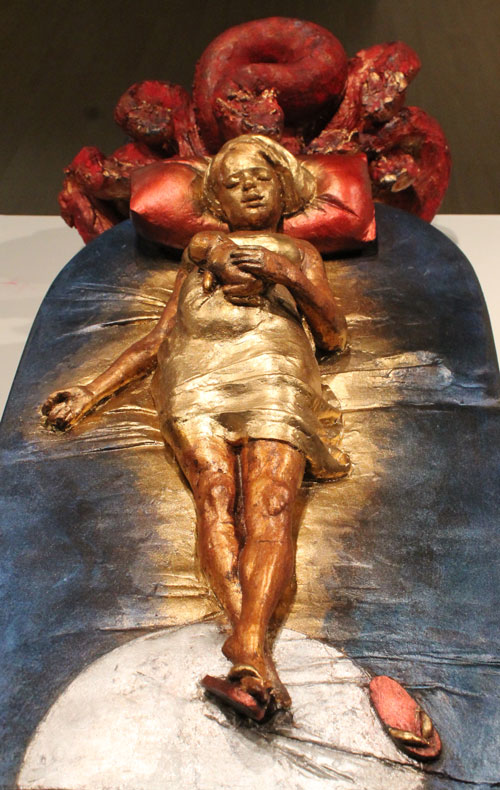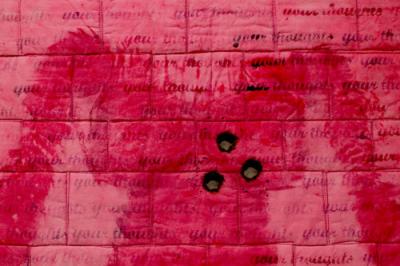Women Artists Confront Injustice
Confronting Injustice: A Woman's Voice Challenges Viewers to Consider Wrongs of Society and What We Might Do to Affect Change
"I have the audacity to believe that peoples everywhere can have three meals a day for their bodies, education and culture for their minds, and dignity, equality, and freedom for their spirits." - Martin Luther King, Jr.
Jan. 15 was Dr. King's birthday. It is fitting then that the opening reception of an art show dedicated to laying bare the injustices of this world and manifesting solutions would have its opening reception that day. Mercyhurst University's noteworthy show, Confronting Injustice: A Woman's Voice challenges all who lay eyes on it to consider what is wrong in our society and what we might do to right those wrongs.
Gallery Director Heather Dana gathered together 25 illustrious regional female artists to undertake the challenge of depicting Mercyhurst University's academic theme for 2014-15: Confronting Injustice. One might presume that an all-women's show would lean the show's thematic motif heavily towards interpretation of women's issues, but instead, the topics chosen for each individual artwork are as varied as the distinct personalities of the artists themselves.
There are, of course, many pieces in the show that pertain to abuse and inequality of women. Of those, the ones that use the traditional women's media of fiber in a new way make a powerful symbolic statement. Since quilting and weaving are so steeped in tradition, the use of those materials and techniques links us to the past of our culture and to cultures all over the world.
Sandy Shelenberger is a textile artist from the Cleveland area whose quilted wall-hanging "Bullet Point Your Thoughts" uses holes burned through the fabric to represent the violence perpetrated against the hearts of women. Womankind is represented by a body print of the artist in a bright pink. Both the feminine softness of the color and the cotton contrasts a brick texture sewn into the fabric and the barely legible words "your thoughts" stenciled throughout the image. Decorating fabric is a traditional home industry currently used by women in many Third World Countries to tap into the international market and lift themselves out of poverty. Shelenberger's piece not only calls attention to an injustice, it seems to offer a solution to one.
As antithetical as it may seem, Marsha Cisek's metal sculpture, "Supplication" is also steeped in the tradition of women's crafts since it is a weaving, although a lattice made of metal is not technically a fabric. The steel wire armature in this small-framed relief is reminiscent of a cage, while pointed red-tipped screws seem to reach out to us, pleading for release from some inescapable prison.
Dana has the show hung thematically, with materials and sizes harmoniously grouped. On the same wall as "Supplication" is Stephanie Wood's similar re-purposed metal assemblage, "Shattered." Wood is best known for lovely watercolors, so it is somewhat disconcerting to see here her presentation of razor blades and safety pins enclosed in a box meant to symbolize the violence and pain of domestic abuse.
 On the other side of Cisek's piece is another framed sculptural surprise: Christine P. Bowler's "Wrong Body... but Sound in Mind and Pure in Spirit" in which a priest throws bowling balls down a flight of stairs knocking nuns over like so many pins as they attempt to climb upwards. What is surprising is that such a blatant questioning of the Catholic Church's policy of denying qualified women the privilege of serving as clergy would appear in the gallery of a Catholic college. Or maybe it is not so surprising: this is Erie, where our nuns have been vocally questioning their glass ceiling for years.
On the other side of Cisek's piece is another framed sculptural surprise: Christine P. Bowler's "Wrong Body... but Sound in Mind and Pure in Spirit" in which a priest throws bowling balls down a flight of stairs knocking nuns over like so many pins as they attempt to climb upwards. What is surprising is that such a blatant questioning of the Catholic Church's policy of denying qualified women the privilege of serving as clergy would appear in the gallery of a Catholic college. Or maybe it is not so surprising: this is Erie, where our nuns have been vocally questioning their glass ceiling for years.
But the majority of the work here is not about women's issues per se. You will find Erie Reader contributor Mary Birdsong's backlit photograph, "Holding Ground" is quite obviously about justice for a metaphorical woman – Mother Earth. In it an uprooted seedling struggles to gain purchase and find sustenance in a stark, plastic, manufactured, and oily world. I find myself rooting for this poor helpless organism as it battles to overcome the odds that mankind has stacked against it. The photo makes me long for spring, so I can again plant a garden and make the world a greener place. An artwork that makes the viewer want to take action is a powerful thing.
Art can have other powerful effects as well. The best art makes us feel deeply. A show dedicated to pointing out injustice in the world can't all be about hope: Sometimes we are going to feel anger, grief, and frustration. Solutions to some of the issues presented here seem out of our reach.
In her quilt "Spoonful of Sugar," Deborah Sementelli points out the result to our health of the ever-increasing amount of sugar present in our diets and how little it seems we can do about it in a world run by mega-corporations bent on selling us as much high-profit, over-processed, genetically-modified "food" as they can. Unhealthful diet is, after all, the world's leading cause of death.
Issues like these beg for solutions, but what are we to do about it in a world where so many others seem bent on heading in the wrong direction?
Mary Elizabeth Meier gives us the solution by questioning the most common response of people to all of these injustices – the fact that we don't respond. Her starkly elegant embossing, "Silence" calls us to examine what we do when we witness injustice. The single white-on-white word is itself a silent rebuke of those who sit by as the world continues to break and decay around them. The powerful message of this show is that none of us should wait for the world to get better.
These women artists have made a difference here in fighting injustice. We can too.
"Human salvation lies in the hands of the creatively maladjusted." - Martin Luther King, Jr.
The show is free and open to the public and runs from Jan. 12 to Feb. 8, weekdays from 9 a.m. to 4 p.m. and weekends from 2 to 5 p.m.


.png)
